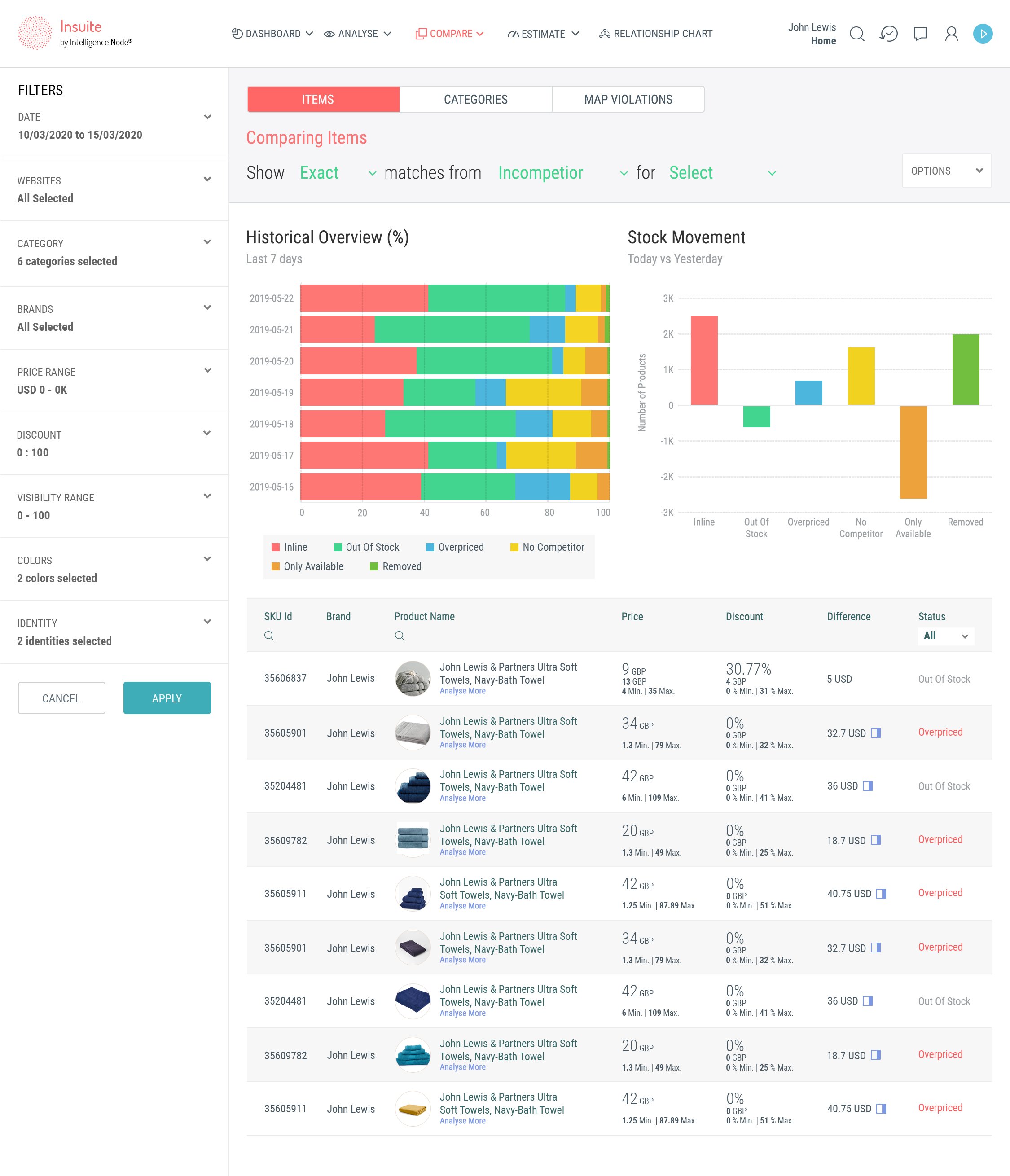Alternatives to Aura
1. Intelligence Node
+Pros
- Real-time competitive monitoring with 10-second data refresh rates
- 99% product matching accuracy through attribute-based similarity engines
- Integration with OpenAI for predictive analytics and AI-generated content
-Cons
- 3-6 month enterprise deployment timeline may challenge organizations requiring rapid deployment
- Implementation complexity requires multiple IT specialists and dedicated pricing teams
One highlighted feature and why it's amazing
The platform's machine learning algorithms process competitive pricing data with 10-second refresh rates, enabling instant market response during promotional periods.

Another highlighted feature of why it’s amazing
Intelligence Node provides comprehensive competitive tracking across 100+ currencies with zip-code-level granularity, enabling international retailers to monitor pricing strategies in specific geographic markets.
2. Pricefx
+Pros
- Algorithmic Transparency Leadership: Pricefx's clear-box AI architecture provides complete visibility into optimization logic and decision-making processes.
- Enterprise-Scale Processing: Proven capability to handle massive scale operations, processing over 1 million SKUs across 200,000 customers.
- Comprehensive ERP Integration: Deep SAP/Oracle integration capabilities provide significant competitive advantages.
- Proven Business Impact: Consistent value delivery with average margin increases of 8.6% within 12 months post-implementation.
- Conversational Analytics Innovation: Natural language interface enables intuitive business conversations, improving team productivity.
-Cons
- Substantial Investment Requirements: Implementation costs ranging from $100,000 to $1.5 million and annual subscriptions of $100,000-$3.5 million create barriers for smaller organizations.
- Extended Implementation Timelines: Deployment timelines of 4.5-6 months exceed lighter alternatives.
- Complex Resource Requirements: Requires dedicated pricing analysts, IT integration specialists, and executive sponsors for successful implementation.
- Limited Scenario Effectiveness: Algorithmic underperformance in luxury goods pricing and relationship-driven B2B scenarios.
- Change Management Intensity: Requires significant investment in change management programs and user adoption strategies.
One highlighted feature and why it's amazing
Provides algorithmic baseline pricing across complex product hierarchies, enabling systematic price management for large SKU catalogs through predictive modeling.

Another highlighted feature of why it’s amazing
Dynamically adjusts contract pricing based on volume commitments and customer tiers, particularly valuable for B2B ecommerce operations requiring sophisticated pricing structures.
Other Alternatives
Prisync
RepricerExpress
Seller Snap
SellerActive
How We Researched This Guide
About This Guide: This comprehensive analysis is based on extensive competitive intelligence and real-world implementation data from leading AI vendors. StayModern updates this guide quarterly to reflect market developments and vendor performance changes.
219+ verified sources per analysis including official documentation, customer reviews, analyst reports, and industry publications.
- • Vendor documentation & whitepapers
- • Customer testimonials & case studies
- • Third-party analyst assessments
- • Industry benchmarking reports
Standardized assessment framework across 8 key dimensions for objective comparison.
- • Technology capabilities & architecture
- • Market position & customer evidence
- • Implementation experience & support
- • Pricing value & competitive position
Research is refreshed every 90 days to capture market changes and new vendor capabilities.
- • New product releases & features
- • Market positioning changes
- • Customer feedback integration
- • Competitive landscape shifts
Every claim is source-linked with direct citations to original materials for verification.
- • Clickable citation links
- • Original source attribution
- • Date stamps for currency
- • Quality score validation
Analysis follows systematic research protocols with consistent evaluation frameworks.
- • Standardized assessment criteria
- • Multi-source verification process
- • Consistent evaluation methodology
- • Quality assurance protocols
Buyer-focused analysis with transparent methodology and factual accuracy commitment.
- • Objective comparative analysis
- • Transparent research methodology
- • Factual accuracy commitment
- • Continuous quality improvement
Quality Commitment: If you find any inaccuracies in our analysis on this page, please contact us at research@staymodern.ai. We're committed to maintaining the highest standards of research integrity and will investigate and correct any issues promptly.